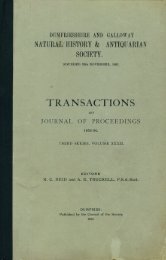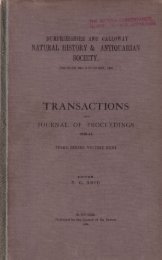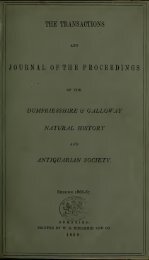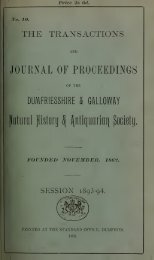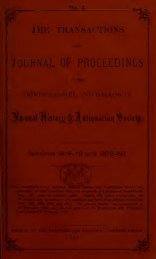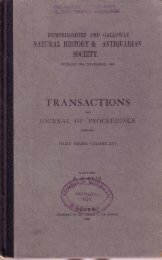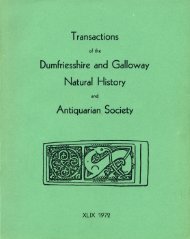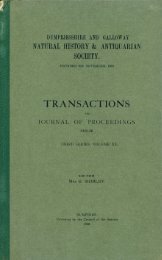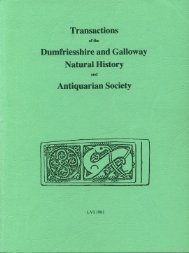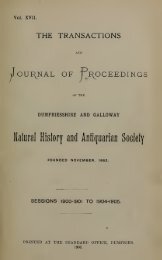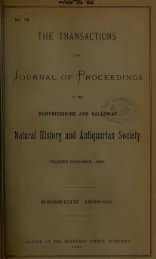- Page 1: Price 4s.THE TRANSACTIONSANDJOURNAL
- Page 4 and 5: —Nothing is so productive of elev
- Page 6 and 7: — —————————-^Kr
- Page 9: Rules.vii.7. The Field Meetings sha
- Page 12 and 13: 2 Transactions.Secketary's Annual K
- Page 14 and 15: 4 Transactions.Douglas's donation o
- Page 16 and 17: 6 TriANSACTIONS.on active service e
- Page 18 and 19: 8 Transactions.that shire and in In
- Page 20 and 21: 10 Transactions.foot-falls had been
- Page 22 and 23: "12 Transactions.shepherd-author, t
- Page 24 and 25: -14 Transactions.^7id of December.M
- Page 26 and 27: 16 Transactions.it, directly in the
- Page 28 and 29: —18 Transactions.Kirkcudbrightshi
- Page 30 and 31: 20 Transactions.ouiythe very commou
- Page 32 and 33: 22 Transactions.brightshire, but no
- Page 34 and 35: 24 Transactions.ness." We luave als
- Page 36 and 37: :26 Transactions.and a few particul
- Page 38 and 39: 28 Transactions.If there be cursing
- Page 42 and 43: :32 Transactions.December and 9 AM.
- Page 44 and 45: ;34 Transactions.227 ft. G in. This
- Page 46 and 47: 36 Transactions.making a careful ca
- Page 48 and 49: the38 TllANSACTIONS.II. Wood-Casile
- Page 50 and 51: 40 Transactions.ground, reaching to
- Page 52 and 53: 42 Transactions.time after the Roma
- Page 54 and 55: 44 Transactions.The discrepancy is
- Page 56 and 57: ;46 Transactions.Common Loft. The T
- Page 58 and 59: ;48 Transactions.Public exposure Ij
- Page 60 and 61: "50 Transactions.Council had been s
- Page 62 and 63: 52 Transactions.vessel lying on the
- Page 64 and 65: 54 Transactions.churches of which w
- Page 66 and 67: 5GTransactions.to Rome through Gaul
- Page 69: II,MONUMENT SERVING NOW AS GATE-POS
- Page 73: IVSTONE IN MIDDLE OF WALL AT THES.W
- Page 76 and 77: 58 Transactions.IV. Tlie. Old Cornk
- Page 78 and 79: 60 Transactions.a pait, and which w
- Page 80 and 81: 62 Transactions.pointed out the pec
- Page 82 and 83: —SESsionsrxsss-sq.f)th 'October,
- Page 84 and 85: 66 Transactions.Donations.—A fine
- Page 86 and 87: 68 Transactions.Some of you at leas
- Page 88 and 89: 70 Transactions.— a most unmerite
- Page 90 and 91:
72 Transactions.Anderson calls it,
- Page 92 and 93:
74 Transactions.sanguinary struggle
- Page 94 and 95:
76 Transactions.Moniaive—surely a
- Page 96 and 97:
78 Transactions.proper nest. In thi
- Page 98 and 99:
80 Transactions.the whole. I have o
- Page 100 and 101:
82 Transactions.ypecies, sliowed me
- Page 102 and 103:
84 Transactions.fourteen in number,
- Page 104 and 105:
86 Transactions.lasting for thousan
- Page 106 and 107:
88 Transactions.ently of a possible
- Page 108 and 109:
..;90 Transactiuns.No.Xame.c ,, var
- Page 110 and 111:
—.—92 Transactions.No.Xame.h Di
- Page 112 and 113:
.;94 Transactions.No.193b194198199N
- Page 114 and 115:
..-;,96 Transactions.N'o.Name.184 E
- Page 116 and 117:
98 Transactions.Mo.Name.289 Polyti-
- Page 118 and 119:
100 Transactions.iVb.Name.481 Eui-h
- Page 120 and 121:
102 Transactions.LIST OF HEPATIC^.N
- Page 122 and 123:
104 Transactions.N'o.Name.83 Blepha
- Page 124 and 125:
;106 Transactions.No.Name.163 Gymno
- Page 126 and 127:
108 Transactions.to the 28th, with
- Page 128 and 129:
1 1 Transactions.exceiitioually dry
- Page 130 and 131:
21 1Transactions.those acquainted w
- Page 132 and 133:
114 Transactions.generations in the
- Page 134 and 135:
—116 TUANSACTIONS.their then stil
- Page 136 and 137:
"118 Transactions.old extent, of Gi
- Page 138 and 139:
120 Transactions.Wodrow was probabl
- Page 140 and 141:
"122 Transactions."Compearit in pre
- Page 142 and 143:
:124 Transactions.3d. Cuthbert Wels
- Page 144 and 145:
:126 Transactions.24M of January, 1
- Page 146 and 147:
128 Transactions.tances to travel b
- Page 148 and 149:
130 Transactions.late Mr Gilchrist
- Page 150 and 151:
—"132 TllANSACTIONS.and character
- Page 152 and 153:
1 34 Transactions.and expounds in s
- Page 154 and 155:
136 Transactions.made up to them by
- Page 156 and 157:
138 Transactions.that the pavements
- Page 158 and 159:
—"—140 Transactions.beheld the
- Page 160 and 161:
142 Transactions.else. Only the oth
- Page 162 and 163:
144 Transactions.The fish in Loch L
- Page 164 and 165:
146 Transactions.ever put into a ri
- Page 166 and 167:
usTllAN.SACTIONS.Wi of April, 1889.
- Page 168 and 169:
—————— ——1 50 Trans
- Page 170 and 171:
152 Transactions.Ncif, the list.In
- Page 172 and 173:
154 Transactions.Burnside, then min
- Page 174 and 175:
156 Transactions.An interesting fie
- Page 176 and 177:
;158 Transactions.of comparison. Al
- Page 178 and 179:
—160 .Transactions.years ago spen
- Page 180 and 181:
162 Transactions.Field Aleeting. \s
- Page 182 and 183:
164 Transactions.buildings of St. N
- Page 184 and 185:
166 Transactions.from the jjrecinct
- Page 186 and 187:
;168 Transactions.pavement was a st
- Page 188 and 189:
170 Transactions.Meeti?2g of Cotcnc
- Page 190 and 191:
SESSIOlSrX88Q-90.ith of October, 18
- Page 192 and 193:
174 Transactions.report.Treasurer's
- Page 194 and 195:
176 Transactions.minerals, never be
- Page 196 and 197:
—178 Transactions.never been fort
- Page 198 and 199:
—180 Transactions.washing gold, o
- Page 200 and 201:
—182 Transactions.Iron Pyrites is
- Page 202 and 203:
184 Transactions.removed, the skin
- Page 204 and 205:
186 Transactions.this gland, a comm
- Page 206 and 207:
188 Transactions.nalia of the Incor
- Page 208 and 209:
190 Transactions.history of this pi
- Page 210 and 211:
now;192 Transactions.note the late
- Page 212 and 213:
194 Transactions.making as complete
- Page 214 and 215:
;196 Transactions.Millisle and abou
- Page 216 and 217:
:196 Transactions.found in consider
- Page 218 and 219:
200 Transactions.from 80 to 170 mil
- Page 220 and 221:
202 Transactions.anticline. Near th
- Page 222 and 223:
204 Transactions.Barometer.—The h
- Page 224 and 225:
206 Transactions.It is worthy of no
- Page 226 and 227:
208 Transactions.old wall, which wa
- Page 228 and 229:
210 Transactions./V. Whorls.—Unti
- Page 230 and 231:
212 Transactions.was thus originall
- Page 232 and 233:
214 Transactions.leaf-shaped swords
- Page 234 and 235:
216 Transactions.been conspicuously
- Page 236 and 237:
;218 Transactions.to elucidate the
- Page 238 and 239:
—220 Transactions.sure, pass away
- Page 240 and 241:
—222 Transactions.eutliusiastic,
- Page 242 and 243:
224 Transactions.1850, the followin
- Page 244 and 245:
226 Transactions.of .£10 to which
- Page 246 and 247:
228 Transactions.Committee's agent
- Page 248 and 249:
—230 Transactions.April, 1821, pa
- Page 250 and 251:
232 Transactions.Mausoleum when on
- Page 252 and 253:
:—234 Transactions.secretaryAllan
- Page 254 and 255:
236 Transactions.ith of April, 1890
- Page 256 and 257:
238 Transactions.the most striking
- Page 258 and 259:
—240 Transactions.Admirals, pure
- Page 260 and 261:
—242 Transactions.convert it into
- Page 262 and 263:
244 Transactions.these words, " and
- Page 264 and 265:
246 Transactions.Town Council on th
- Page 266 and 267:
—248 Transactions.Natural History
- Page 268 and 269:
March,250 Transactions.most were :7
- Page 270 and 271:
252 Transactions.some degree upon t
- Page 272 and 273:
———254 Transactions.plant sca
- Page 274 and 275:
256 Transactions.There is prefixed
- Page 276 and 277:
258 Transactions.Lyes uninclosed, u
- Page 278 and 279:
:260 Transactions.idols of wood out
- Page 280 and 281:
262 Transactions.4, The Town having
- Page 282:
264 Tkansactions.packing of small s
- Page 286 and 287:
—266 Transactions.with a running
- Page 288 and 289:
268 Transactions.hedges of giant st
- Page 290 and 291:
270 Transactions.written, Levenaux
- Page 292 and 293:
272 Transactions.Twyse borne ou ear
- Page 294 and 295:
274 Transactions.the Isle of Man, w
- Page 296 and 297:
276 Transactions.consultation by an
- Page 298 and 299:
John Adair, High Street, Dumfries.D
- Page 300 and 301:
280 OiiDiNAHY Members.John M'Kie, A
- Page 302:
282 Ordinary Members.Rev. Robert W.



